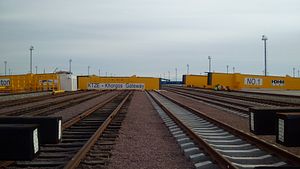A new epicenter of transportation and trade is growing up from the barren dunes in the far east of Kazakhstan on the Chinese border. It is called Khorgos Eastern Gate, and it is a massive special economic zone that, in the words of its builders, is set to change the map of logistics. Located on the site of what was once a major junction on the ancient Silk Road, Khorgos is being revived again as part of the new Silk Road Economic Belt, the overland portion of China’s Belt and Road initiative, an immense trillion dollar endeavor that aims to increase infrastructural, economic, and political connectivity between more than 60 countries across Eurasia.
“Where you are standing right now is where the East meets the West,” a smiling man in an orange safety vest called out to me as he approached with an outstretched hand. “Really, this is the place,” he added, as though I didn’t believe him. He introduced himself as Karl Gheysen, the CEO of Khorgos Gateway, the company managing the dry port that I was visiting.
We were standing before a set of four railway tracks lying side by side, the place where trans-continental China-Europe trains stop to relay their cargo. China’s rail gauge is 85 mm narrower than those in the former Soviet sphere, so containers need to be transferred onto local gauge trains at the border before continuing onward. Gheysen’s white safety helmet rocked from side to side as he theatrically pointed out the directions of trade routes emanating from China, India, Iran, Turkey, and Europe which converged together right where we stood – the point at which the economies of the East meet those of the West, as Gheysen liked to put it.

































